Holly Thompson's Blog, page 31
February 1, 2013
COETAIL--Changing the Way the World Learns...in Cambodia?
After reading the blog post Disrupting Class--An Overview, about Clayton Christensen, Michael Horn and Curtis Johnson's book
Disrupting Class: How Disruptive Innovation Will Change the Way the World Learns
I've downloaded the book to my Kindle. I haven't had a chance to skim through Disrupting Class yet, but the blog post raises interesting questions.
The post explains that disruptive innovation within the educational sphere is taking place in two phases--computer-based learning followed by student-centric learning focused on customization that "will allow the teachers, parents and the learner to customize the system to help learners to learn each subject in the ways that their brains are wired to learn."
The post raises some interesting questions at the end and led to my own reflections, especially as I am about to depart for Cambodia where for part of my stay I'll spend five days in a village as a volunteer teacher in a free after-school English school. According to World Bank data, Cambodia's internet users per 100 people number a mere 3.1. In the village where I will stay, many huts have no electricity. Few people have computers. Classes at this school are in a simple school room.
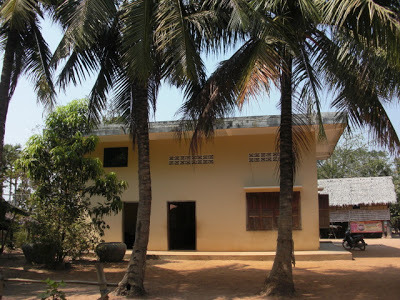
 The teachers there teach following their teacher role models--as heads of the classroom, pointing to words on the whiteboard. The children take turns with the pointer reciting the sentence example.
The teachers there teach following their teacher role models--as heads of the classroom, pointing to words on the whiteboard. The children take turns with the pointer reciting the sentence example.
 The last time I visited the village in 2010, I used my earnings from an international school visit to purchase the head teacher his own computer. But the reality is, he has to travel an hour by motorbike to Phnom Penh for Internet access. My travel gift this year is a solar lamp from Ikea.
The last time I visited the village in 2010, I used my earnings from an international school visit to purchase the head teacher his own computer. But the reality is, he has to travel an hour by motorbike to Phnom Penh for Internet access. My travel gift this year is a solar lamp from Ikea.
Meanwhile at the opposite end of the spectrum, many students in other parts of the world in both public and private schools have one-to-one laptop usage, are already in the customization phase, and teachers have a community of experienced educators with whom to learn from and share ideas both face-to-face and online.
Given the state of affairs in Cambodia and other developing countries around the world, perhaps in addition to enabling access to clean water and education, we in the developed world should be establishing innovative ways to create more hubs of internet access, in schools and in the form of libraries containing both print materials and internet connected computers, to also function as centers for teachers to develop as twenty-first century educators.
Education throughout the world seems to be divided into technology haves and have nots. Can we train technology leaders and educators in these developing countries to help them customize education approaches to suit their needs? Will politics and cultural tradition stifle such efforts? In Confucian influenced Asia, how easily can the traditional teacher roles shift? I look forward to observing the Cambodian village classroom and hope to conduct a survey of internet access with the students I meet.
The post explains that disruptive innovation within the educational sphere is taking place in two phases--computer-based learning followed by student-centric learning focused on customization that "will allow the teachers, parents and the learner to customize the system to help learners to learn each subject in the ways that their brains are wired to learn."
The post raises some interesting questions at the end and led to my own reflections, especially as I am about to depart for Cambodia where for part of my stay I'll spend five days in a village as a volunteer teacher in a free after-school English school. According to World Bank data, Cambodia's internet users per 100 people number a mere 3.1. In the village where I will stay, many huts have no electricity. Few people have computers. Classes at this school are in a simple school room.

 The teachers there teach following their teacher role models--as heads of the classroom, pointing to words on the whiteboard. The children take turns with the pointer reciting the sentence example.
The teachers there teach following their teacher role models--as heads of the classroom, pointing to words on the whiteboard. The children take turns with the pointer reciting the sentence example.  The last time I visited the village in 2010, I used my earnings from an international school visit to purchase the head teacher his own computer. But the reality is, he has to travel an hour by motorbike to Phnom Penh for Internet access. My travel gift this year is a solar lamp from Ikea.
The last time I visited the village in 2010, I used my earnings from an international school visit to purchase the head teacher his own computer. But the reality is, he has to travel an hour by motorbike to Phnom Penh for Internet access. My travel gift this year is a solar lamp from Ikea.Meanwhile at the opposite end of the spectrum, many students in other parts of the world in both public and private schools have one-to-one laptop usage, are already in the customization phase, and teachers have a community of experienced educators with whom to learn from and share ideas both face-to-face and online.
Given the state of affairs in Cambodia and other developing countries around the world, perhaps in addition to enabling access to clean water and education, we in the developed world should be establishing innovative ways to create more hubs of internet access, in schools and in the form of libraries containing both print materials and internet connected computers, to also function as centers for teachers to develop as twenty-first century educators.
Education throughout the world seems to be divided into technology haves and have nots. Can we train technology leaders and educators in these developing countries to help them customize education approaches to suit their needs? Will politics and cultural tradition stifle such efforts? In Confucian influenced Asia, how easily can the traditional teacher roles shift? I look forward to observing the Cambodian village classroom and hope to conduct a survey of internet access with the students I meet.
Published on February 01, 2013 19:06
Changing the Way the World Learns...in Cambodia?
After reading the blog post Disrupting Class--An Overview, about Clayton Christensen, Michael Horn and Curtis Johnson's book
Disrupting Class: How Disruptive Innovation Will Change the Way the World Learns
I've downloaded the book to my Kindle. I haven't had a chance to skim through Disrupting Class yet, but the blog post raises interesting questions.
The post explains that disruptive innovation within the educational sphere is taking place in two phases--computer-based learning followed by student-centric learning focused on customization that "will allow the teachers, parents and the learner to customize the system to help learners to learn each subject in the ways that their brains are wired to learn."
The post raises some interesting questions at the end and led to my own reflections, especially as I am about to depart for Cambodia where for part of my stay I'll spend five days in a village as a volunteer teacher in a free after-school English school. According to World Bank data, Cambodia's internet users per 100 people number a mere 3.1. In the village where I will stay, many huts have no electricity. Few people have computers. Classes at this school are in a simple school room.

 The teachers there teach following their teacher role models--as heads of the classroom, pointing to words on the whiteboard. The children take turns with the pointer reciting the sentence example.
The teachers there teach following their teacher role models--as heads of the classroom, pointing to words on the whiteboard. The children take turns with the pointer reciting the sentence example.
 The last time I visited the village in 2010, I used my earnings from an international school visit to purchase the head teacher his own computer. But the reality is, he has to travel an hour by motorbike to Phnom Penh for Internet access. My travel gift this year is a solar lamp from Ikea.
The last time I visited the village in 2010, I used my earnings from an international school visit to purchase the head teacher his own computer. But the reality is, he has to travel an hour by motorbike to Phnom Penh for Internet access. My travel gift this year is a solar lamp from Ikea.
Meanwhile at the opposite end of the spectrum, many students in other parts of the world in both public and private schools have one-to-one laptop usage, are already in the customization phase, and teachers have a community of experienced educators with whom to learn from and share ideas both face-to-face and online.
Given the state of affairs in Cambodia and other developing countries around the world, perhaps in addition to enabling access to clean water and education, we in the developed world should be establishing innovative ways to create more hubs of internet access, in schools and in the form of libraries containing both print materials and internet connected computers, to also function as centers for teachers to develop as twenty-first century educators.
Education throughout the world seems to be divided into technology haves and have nots. Can we train technology leaders and educators in these developing countries to help them customize education approaches to suit their needs? Will politics and cultural tradition stifle such efforts? In Confucian influenced Asia, how easily can the traditional teacher roles shift? I look forward to observing the Cambodian village classroom and hope to conduct a survey of internet access with the students I meet.
The post explains that disruptive innovation within the educational sphere is taking place in two phases--computer-based learning followed by student-centric learning focused on customization that "will allow the teachers, parents and the learner to customize the system to help learners to learn each subject in the ways that their brains are wired to learn."
The post raises some interesting questions at the end and led to my own reflections, especially as I am about to depart for Cambodia where for part of my stay I'll spend five days in a village as a volunteer teacher in a free after-school English school. According to World Bank data, Cambodia's internet users per 100 people number a mere 3.1. In the village where I will stay, many huts have no electricity. Few people have computers. Classes at this school are in a simple school room.

 The teachers there teach following their teacher role models--as heads of the classroom, pointing to words on the whiteboard. The children take turns with the pointer reciting the sentence example.
The teachers there teach following their teacher role models--as heads of the classroom, pointing to words on the whiteboard. The children take turns with the pointer reciting the sentence example.  The last time I visited the village in 2010, I used my earnings from an international school visit to purchase the head teacher his own computer. But the reality is, he has to travel an hour by motorbike to Phnom Penh for Internet access. My travel gift this year is a solar lamp from Ikea.
The last time I visited the village in 2010, I used my earnings from an international school visit to purchase the head teacher his own computer. But the reality is, he has to travel an hour by motorbike to Phnom Penh for Internet access. My travel gift this year is a solar lamp from Ikea.Meanwhile at the opposite end of the spectrum, many students in other parts of the world in both public and private schools have one-to-one laptop usage, are already in the customization phase, and teachers have a community of experienced educators with whom to learn from and share ideas both face-to-face and online.
Given the state of affairs in Cambodia and other developing countries around the world, perhaps in addition to enabling access to clean water and education, we in the developed world should be establishing innovative ways to create more hubs of internet access, in schools and in the form of libraries containing both print materials and internet connected computers, to also function as centers for teachers to develop as twenty-first century educators.
Education throughout the world seems to be divided into technology haves and have nots. Can we train technology leaders and educators in these developing countries to help them customize education approaches to suit their needs? Will politics and cultural tradition stifle such efforts? In Confucian influenced Asia, how easily can the traditional teacher roles shift? I look forward to observing the Cambodian village classroom and hope to conduct a survey of internet access with the students I meet.
Published on February 01, 2013 19:06
COETAIL--Driving at Night
Last week I embarked on a new endeavor–COETAIL@YIS
For the next year or so, some posts on this blog will be categorized as COETAIL (Certificate of Educational Technology and Information Literacy). As a writing teacher at the university level and as a guest author often visiting classrooms across Asia and the U.S., I aim to better equip myself to integrate technology into my face-to-face and classroom roles as both an educator and creator.
In a Paris Review interview author E.L. Doctorow, my thesis advisor in the N.Y.U. Creative Writing Program, said that writing a novel is “like driving a car at night: you never see further than your headlights, but you can make the whole trip that way.”
And in this new educational technology endeavor, as with my poetry and fiction writing, I'll be driving at night in a way. I know I’ll end up in some culverts and wander off the main road at times, but that’s all part of the journey.
Yet I know that there are other experienced COETAILers out there to give me pointers and help me find my way. I know that the road at times will be unlit, but with technology and education today it's more like driving at night in a city. There are plenty of lights along the way and the assurance of many voices and opinions to consider. I look forward to to this new COETAIL educational journey.

For the next year or so, some posts on this blog will be categorized as COETAIL (Certificate of Educational Technology and Information Literacy). As a writing teacher at the university level and as a guest author often visiting classrooms across Asia and the U.S., I aim to better equip myself to integrate technology into my face-to-face and classroom roles as both an educator and creator.
In a Paris Review interview author E.L. Doctorow, my thesis advisor in the N.Y.U. Creative Writing Program, said that writing a novel is “like driving a car at night: you never see further than your headlights, but you can make the whole trip that way.”
And in this new educational technology endeavor, as with my poetry and fiction writing, I'll be driving at night in a way. I know I’ll end up in some culverts and wander off the main road at times, but that’s all part of the journey.
Yet I know that there are other experienced COETAILers out there to give me pointers and help me find my way. I know that the road at times will be unlit, but with technology and education today it's more like driving at night in a city. There are plenty of lights along the way and the assurance of many voices and opinions to consider. I look forward to to this new COETAIL educational journey.

Published on February 01, 2013 17:27
January 31, 2013
It's That Season--Wakame!
This week the wakame harvest began in Kamakura under perfect sunny skies. At last, early on Wednesday morning, I had a brief window of time to hit the beach . . . just as the wakame boats were being hauled up onto the sand. The wood fires were burning, the water was boiling, the clothes pins were dangling--all was ready. I love the whole scene.
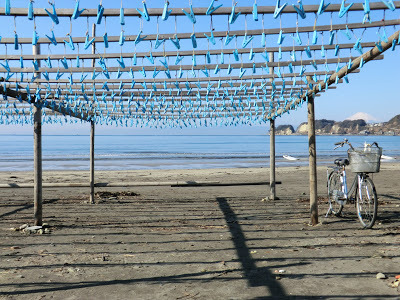
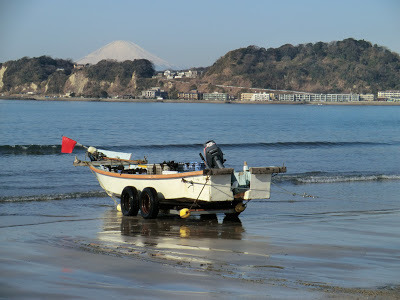
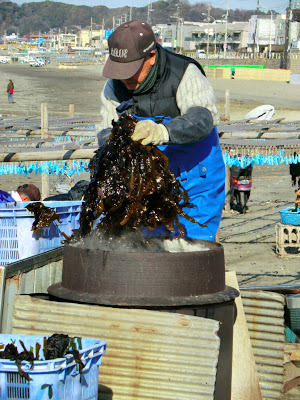
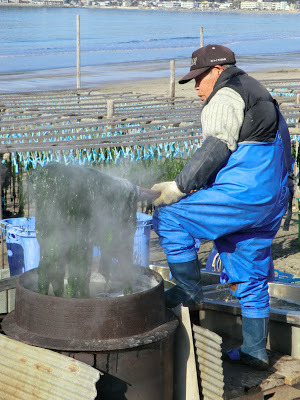


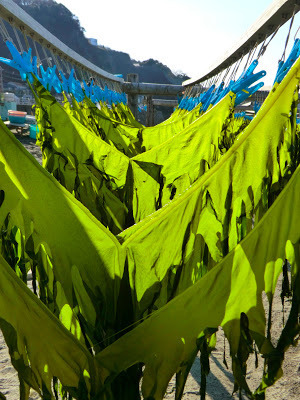
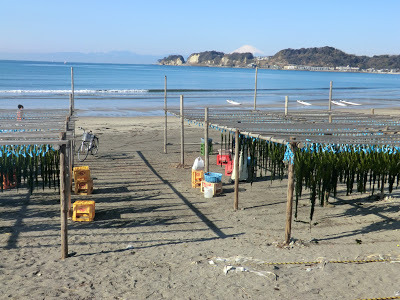 I bought a nice bag full of just boiled wakame and enjoyed a huge serving with ponzu for lunch.
I bought a nice bag full of just boiled wakame and enjoyed a huge serving with ponzu for lunch.
And today, I brought fresh wakame to Tokyo International School where I was talking about The Wakame Gatherers to elementary school students. At the end of my presentations on wakame cultivation, harvesting, boiling and drying the kids sampled the wakame . . . and came back for seconds and thirds. The plates were empty after each session. There is nothing quite like freshly harvested wakame--crunchy taste of the sea.







 I bought a nice bag full of just boiled wakame and enjoyed a huge serving with ponzu for lunch.
I bought a nice bag full of just boiled wakame and enjoyed a huge serving with ponzu for lunch.And today, I brought fresh wakame to Tokyo International School where I was talking about The Wakame Gatherers to elementary school students. At the end of my presentations on wakame cultivation, harvesting, boiling and drying the kids sampled the wakame . . . and came back for seconds and thirds. The plates were empty after each session. There is nothing quite like freshly harvested wakame--crunchy taste of the sea.
Published on January 31, 2013 06:26
January 24, 2013
Narrative Poetry and East Asian Books in Singapore
Last week I traveled to Singapore for school visits at the East Campus of United World College South East Asia. I'd heard so much about UWCSEA for years so it was a treat to finally visit, talk books over several days with librarian Katie Day, meet and hang out with teachers, and talk poetry and writing with middle school students.
My schedule was wonderful. On the first day I spoke to all three middle school grades during an assembly. After that, over two days, I had double 80-minute periods with groups of grade 6, 7 and 8 students who had signed up for my workshops. Which is to say, 160 minutes with each group of eager students. What a gift! We read many narrative poems, talked poetic elements, brainstormed, and wrote first drafts. And now I'm seeing revised poems shared with me in a Google doc.
The third day was a mini-conference, Texts Worth Teaching: East Asia (check out the excellent list of supporting resources/links), held in the beautiful East Campus library. I loved hearing Kirpal Singh talk about reading and writing within the context of the Singapore, as well as approaches to taboo topics. Robert Yeo shared his linguistic journey from Baba Malay to writing in English and discussed writing for the audience you know best. He shared his beautiful poem "Malacca Grandmother" and introduced the audience to the works of Filipino author F. Sionil José and Malaysian writer Kee Thuan Chye. In my talk, I spoke about stories from Japan and gave a brief overview of children's and YA books from Japan available in English translation, as well as English-language children's and YA books related to Japan (many of these books are in my Goodreads shelves). I also spoke of SCBWI in Japan, the SCBWI Tokyo Translation Group and forthcoming works by writers based in Japan. Finally I talked about my own The Wakame Gatherers, Orchards, The Language Inside, and my poetry and works in progress in the context of my aim to see more of Asia appearing in books published in North America. There were sharing sessions--opportunities for participating teachers and librarians to recommend books relating to East Asia, and there were tables of books by Singaporean writers for sale. I was pleased to find Let Me Tell You Something About That Night--Strange Tales by Cyril Wong. An added bonus was having the chance to meet one of the book bloggers (Confessions of a Readaholic) behind the ambitious project Books That Glow: MG & YA 2013.
Singapore delivered about 24 hours of pouring rain while I was there, but I did have a lovely late afternoon walk with a teacher before the deluge along the East Coast. Some serious sand castling there:
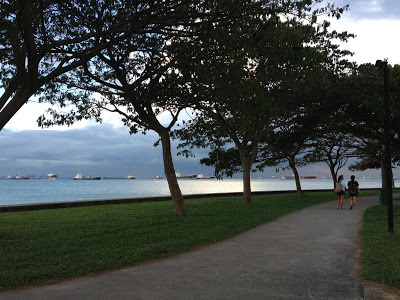


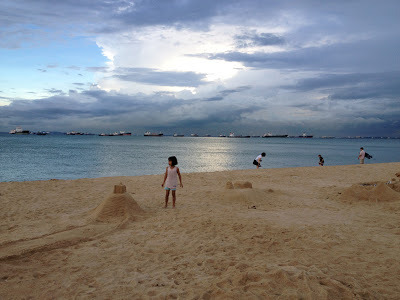
Thank you to UWCSEA and especially to librarian Katie Day for organizing this wonderful visit.
My schedule was wonderful. On the first day I spoke to all three middle school grades during an assembly. After that, over two days, I had double 80-minute periods with groups of grade 6, 7 and 8 students who had signed up for my workshops. Which is to say, 160 minutes with each group of eager students. What a gift! We read many narrative poems, talked poetic elements, brainstormed, and wrote first drafts. And now I'm seeing revised poems shared with me in a Google doc.
The third day was a mini-conference, Texts Worth Teaching: East Asia (check out the excellent list of supporting resources/links), held in the beautiful East Campus library. I loved hearing Kirpal Singh talk about reading and writing within the context of the Singapore, as well as approaches to taboo topics. Robert Yeo shared his linguistic journey from Baba Malay to writing in English and discussed writing for the audience you know best. He shared his beautiful poem "Malacca Grandmother" and introduced the audience to the works of Filipino author F. Sionil José and Malaysian writer Kee Thuan Chye. In my talk, I spoke about stories from Japan and gave a brief overview of children's and YA books from Japan available in English translation, as well as English-language children's and YA books related to Japan (many of these books are in my Goodreads shelves). I also spoke of SCBWI in Japan, the SCBWI Tokyo Translation Group and forthcoming works by writers based in Japan. Finally I talked about my own The Wakame Gatherers, Orchards, The Language Inside, and my poetry and works in progress in the context of my aim to see more of Asia appearing in books published in North America. There were sharing sessions--opportunities for participating teachers and librarians to recommend books relating to East Asia, and there were tables of books by Singaporean writers for sale. I was pleased to find Let Me Tell You Something About That Night--Strange Tales by Cyril Wong. An added bonus was having the chance to meet one of the book bloggers (Confessions of a Readaholic) behind the ambitious project Books That Glow: MG & YA 2013.
Singapore delivered about 24 hours of pouring rain while I was there, but I did have a lovely late afternoon walk with a teacher before the deluge along the East Coast. Some serious sand castling there:




Thank you to UWCSEA and especially to librarian Katie Day for organizing this wonderful visit.
Published on January 24, 2013 21:38
January 3, 2013
Kamakura New Year 2013
This year we were traveling until a couple days before the New Year--which left us little time to clean house, shop for New Year's foods, cook, and write and send our New Year's cards (the subject of my December 2012 DoubleTake column in the ANA inflight magazine Wingspan). But without making ourselves crazy, we managed to, more or less, do it all.
On New Year's Eve, we saw the last sunset of 2012
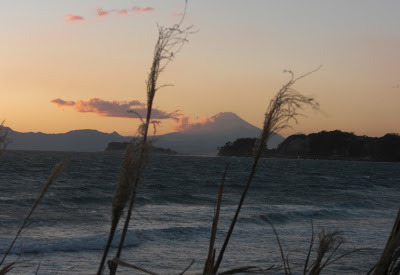 and ate our dinner of toshikoshi soba noodles for longevity. We watched a bit of Kohaku on TV, then near midnight went to the temple Hongakuji to ring the bell.
and ate our dinner of toshikoshi soba noodles for longevity. We watched a bit of Kohaku on TV, then near midnight went to the temple Hongakuji to ring the bell.
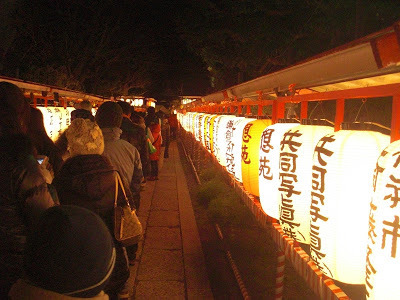 the long wait to ring the bell
the long wait to ring the bell
 the temple bell, typically rung 108 times On New Year's Day we caught up on our cooking for the New Year's feast (most people have fully prepared their osechi meal by a day or two before). Our humble but tasty version included ozoni soup, some of the traditional New Year's foods, plus yuzu stewed apples, green tea tempura fried lucky beans, vegetarian makizushi, stuffed lotus root, and salmon wraps.
the temple bell, typically rung 108 times On New Year's Day we caught up on our cooking for the New Year's feast (most people have fully prepared their osechi meal by a day or two before). Our humble but tasty version included ozoni soup, some of the traditional New Year's foods, plus yuzu stewed apples, green tea tempura fried lucky beans, vegetarian makizushi, stuffed lotus root, and salmon wraps.
 this year's version of osechi And for the first three days of the New Year, we've made the rounds to various temples and shrines, enjoying the no traffic rules in the city and the beautiful weather.
this year's version of osechi And for the first three days of the New Year, we've made the rounds to various temples and shrines, enjoying the no traffic rules in the city and the beautiful weather.
 Ebisu hall at Hongakuji
Ebisu hall at Hongakuji
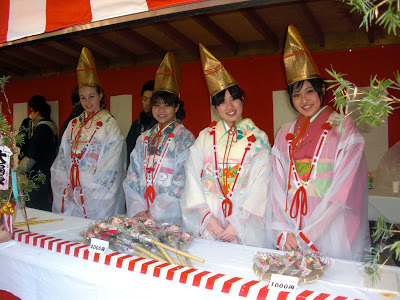 Fukumusume temple maidens at Hongakuji
Fukumusume temple maidens at Hongakuji
 crowds climbing the stairs to Hachimangu
crowds climbing the stairs to Hachimangu
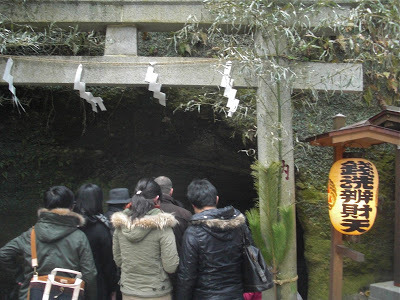 lines extending out the tunnel approach of Zeniaraibenten Shrine
lines extending out the tunnel approach of Zeniaraibenten Shrine
 live music at the Kamakura vegetable marketSo from Kamakura, here's wishing you a very Happy Year of the Snake!
live music at the Kamakura vegetable marketSo from Kamakura, here's wishing you a very Happy Year of the Snake!
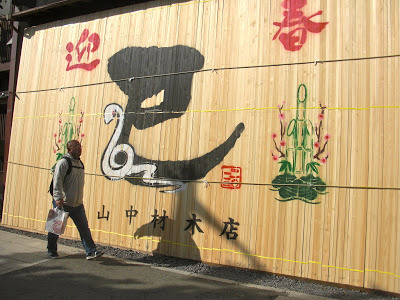 Kamakura lumber shop New Year's greetings
Kamakura lumber shop New Year's greetings
On New Year's Eve, we saw the last sunset of 2012
 and ate our dinner of toshikoshi soba noodles for longevity. We watched a bit of Kohaku on TV, then near midnight went to the temple Hongakuji to ring the bell.
and ate our dinner of toshikoshi soba noodles for longevity. We watched a bit of Kohaku on TV, then near midnight went to the temple Hongakuji to ring the bell. the long wait to ring the bell
the long wait to ring the bell
 the temple bell, typically rung 108 times On New Year's Day we caught up on our cooking for the New Year's feast (most people have fully prepared their osechi meal by a day or two before). Our humble but tasty version included ozoni soup, some of the traditional New Year's foods, plus yuzu stewed apples, green tea tempura fried lucky beans, vegetarian makizushi, stuffed lotus root, and salmon wraps.
the temple bell, typically rung 108 times On New Year's Day we caught up on our cooking for the New Year's feast (most people have fully prepared their osechi meal by a day or two before). Our humble but tasty version included ozoni soup, some of the traditional New Year's foods, plus yuzu stewed apples, green tea tempura fried lucky beans, vegetarian makizushi, stuffed lotus root, and salmon wraps.  this year's version of osechi And for the first three days of the New Year, we've made the rounds to various temples and shrines, enjoying the no traffic rules in the city and the beautiful weather.
this year's version of osechi And for the first three days of the New Year, we've made the rounds to various temples and shrines, enjoying the no traffic rules in the city and the beautiful weather. Ebisu hall at Hongakuji
Ebisu hall at Hongakuji
 Fukumusume temple maidens at Hongakuji
Fukumusume temple maidens at Hongakuji crowds climbing the stairs to Hachimangu
crowds climbing the stairs to Hachimangu
 lines extending out the tunnel approach of Zeniaraibenten Shrine
lines extending out the tunnel approach of Zeniaraibenten Shrine live music at the Kamakura vegetable marketSo from Kamakura, here's wishing you a very Happy Year of the Snake!
live music at the Kamakura vegetable marketSo from Kamakura, here's wishing you a very Happy Year of the Snake! Kamakura lumber shop New Year's greetings
Kamakura lumber shop New Year's greetings
Published on January 03, 2013 02:21
December 31, 2012
2012 Highlight Trip to Egypt and Hopes for 2013
Years ago when we still lived in the U.S. we began a New Year's Eve tradition with some close friends and family of sharing our personal highlights of the past year, then sharing hopes and dreams for the coming year. Mixed in with various Japanese New Year's customs, we have continued this tradition with our children over the years in Japan.
Some of my own highlights of 2012 included the launch of Tomo: Friendship Through Fiction ; writing and school visit travels that took me to Vietnam, Thailand, Hong Kong and China; attending ALA and SCBWI LA; completing my novel The Language Inside ; visits with family in the U.S.; and various big moments of the year for our children. But certainly the highest of highlights of 2012, was our recent trip to Egypt to visit our son studying for a year in Cairo.
Cairo is a complicated city, ever more so nowadays, and not an easy city for travel. Thankfully protests were minimal during our visit, and despite the smog, messy streets, crazy traffic and ubiquitous hawkers, we had a phenomenal time. Our son was a savvy guide and took us to his favorite city sights and eating spots. Besides Cairo, we spent several days in Luxor.
Here are some of the highlights of this 2012 highlight trip.
The pyramids of Giza . . .

Hatshepsut's Temple in Luxor . . .

Desert Paradise Lodge, our accommodations in Luxor . . .

Sunrise from the lodge . . .
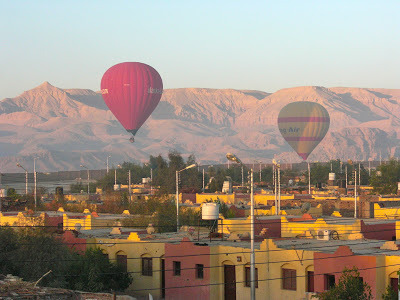 Temple of Karnak in Luxor . . .
Temple of Karnak in Luxor . . .
 and the Nile river valley.
and the Nile river valley.
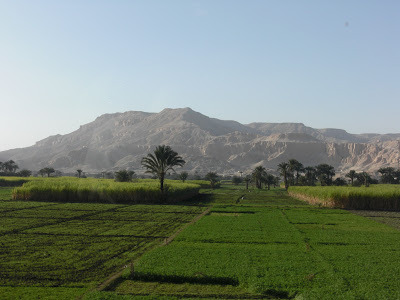 The Citadel in Cairo . . .
The Citadel in Cairo . . .

Ibn Tulun Mosque . . .
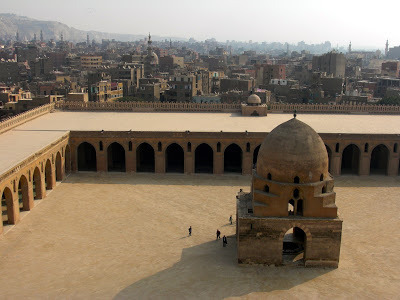
The Gayer-Anderson Museum (where a scene from The Spy Who Loved Me was filmed) . . .



Cairo street life . . .

pita bread every day. . .

mellow Tahrir Square . . .
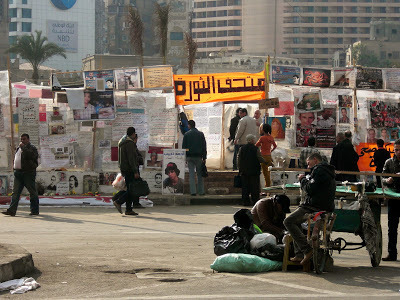
and downtown Cairo.

There was plenty more--wild taxi rides, Yemeni food, women-only cars on the metro, lunch of koshary, Nile views, the Ibn Tulun minaret, sphinxes, donkeys, cats, and even a lucky sighting of a hoopoe bird at Medinet Habu Temple of Ramesses III.
 photo courtesy of Wikimedia CommonsOn our last evening in Cairo, our family lingered over mint tea after a meal at the Lebanese restaurant Taboula sharing our highlights of the past year and our hopes and dreams for the coming year. Some highlights and hopes had us all laughing; others brought tears to our eyes.
photo courtesy of Wikimedia CommonsOn our last evening in Cairo, our family lingered over mint tea after a meal at the Lebanese restaurant Taboula sharing our highlights of the past year and our hopes and dreams for the coming year. Some highlights and hopes had us all laughing; others brought tears to our eyes.
So my own hopes and dreams for 2013? Well, I know there will be more travel--Singapore, Cambodia, the U.S. and Korea in just the first five months of the new year. Amidst all that moving around, I hope for the usual peace, safety and good health for my loved ones and no major earthquakes in Japan. Beyond that, I hope to do some of my best writing, deliver some dynamic school visits, positively influence the world in some small ways, and, stealing the words of my daughter as she summed up her hopes: "be happy."
Wishing everyone some warm moments with friends or family with whom to share highlights of 2012 and hopes for 2013. Kanpai!
Some of my own highlights of 2012 included the launch of Tomo: Friendship Through Fiction ; writing and school visit travels that took me to Vietnam, Thailand, Hong Kong and China; attending ALA and SCBWI LA; completing my novel The Language Inside ; visits with family in the U.S.; and various big moments of the year for our children. But certainly the highest of highlights of 2012, was our recent trip to Egypt to visit our son studying for a year in Cairo.
Cairo is a complicated city, ever more so nowadays, and not an easy city for travel. Thankfully protests were minimal during our visit, and despite the smog, messy streets, crazy traffic and ubiquitous hawkers, we had a phenomenal time. Our son was a savvy guide and took us to his favorite city sights and eating spots. Besides Cairo, we spent several days in Luxor.
Here are some of the highlights of this 2012 highlight trip.
The pyramids of Giza . . .

Hatshepsut's Temple in Luxor . . .

Desert Paradise Lodge, our accommodations in Luxor . . .

Sunrise from the lodge . . .
 Temple of Karnak in Luxor . . .
Temple of Karnak in Luxor . . . and the Nile river valley.
and the Nile river valley.  The Citadel in Cairo . . .
The Citadel in Cairo . . .
Ibn Tulun Mosque . . .

The Gayer-Anderson Museum (where a scene from The Spy Who Loved Me was filmed) . . .



Cairo street life . . .

pita bread every day. . .

mellow Tahrir Square . . .

and downtown Cairo.

There was plenty more--wild taxi rides, Yemeni food, women-only cars on the metro, lunch of koshary, Nile views, the Ibn Tulun minaret, sphinxes, donkeys, cats, and even a lucky sighting of a hoopoe bird at Medinet Habu Temple of Ramesses III.
 photo courtesy of Wikimedia CommonsOn our last evening in Cairo, our family lingered over mint tea after a meal at the Lebanese restaurant Taboula sharing our highlights of the past year and our hopes and dreams for the coming year. Some highlights and hopes had us all laughing; others brought tears to our eyes.
photo courtesy of Wikimedia CommonsOn our last evening in Cairo, our family lingered over mint tea after a meal at the Lebanese restaurant Taboula sharing our highlights of the past year and our hopes and dreams for the coming year. Some highlights and hopes had us all laughing; others brought tears to our eyes.So my own hopes and dreams for 2013? Well, I know there will be more travel--Singapore, Cambodia, the U.S. and Korea in just the first five months of the new year. Amidst all that moving around, I hope for the usual peace, safety and good health for my loved ones and no major earthquakes in Japan. Beyond that, I hope to do some of my best writing, deliver some dynamic school visits, positively influence the world in some small ways, and, stealing the words of my daughter as she summed up her hopes: "be happy."
Wishing everyone some warm moments with friends or family with whom to share highlights of 2012 and hopes for 2013. Kanpai!
Published on December 31, 2012 03:25
December 8, 2012
Crystal Kite Award for Verse Novel Orchards
Earlier this year I learned that my verse novel Orchards won the 2012 SCBWI Crystal Kite Award for the Middle East/India/Asia region.
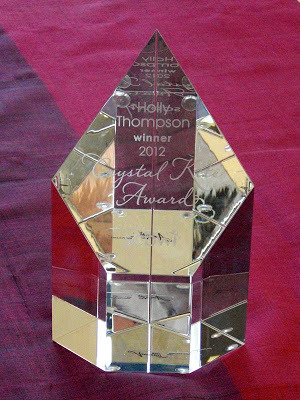 2012 Crystal Kite Award for Orchards
2012 Crystal Kite Award for Orchards
SCBWI's Lee Wind did an interview with me on the SCBWI Blog about the award and my involvement with SCBWI.
And on Friday evening at SCBWI Tokyo's final event of 2012, I was completely surprised with an award presentation made by my wonderful Assistant Regional Advisor Jenny Desmond Walters who said some lovely words about first encountering early drafts of Orchards when she was a member of the SCBWI Tokyo online critique group her first time living in Japan about seven years ago--stories do go from scribbles, to full drafts, to publication.
 Receiving the Crystal Kite Award at the SCBWI Tokyo Bonenkai dinner
Receiving the Crystal Kite Award at the SCBWI Tokyo Bonenkai dinner
The SCBWI announcement of the 2012 Crystal Kite award winners shares these words about the awards:
The SCBWI Crystal Kite Awards recognize great books from the 70 SCBWI regions around the world. Each regional chapter was assigned to one of 15 divisions and the membership in each division voted for their favorite book published by an SCBWI member that year. “The SCBWI is pleased to reward excellence in children’s books,” President Stephen Mooser stated. “These awards honor authors from our many regions and help bring worthy books into the spotlight.”
The Crystal Kite Awards are a regional complement of the annual SCBWI Golden Kite Award which are given in 4 children’s literature categories. Both awards are unique as they are chosen by other writers and illustrators, making them the only peer-given awards in publishing for young readers. “Like the Golden Kite Awards, the Crystal Kites are selected by peers---authors and artists working in the children’s book field,” SCBWI Executive Director Lin Oliver commented. “That makes them unique and especially satisfying to receive.”
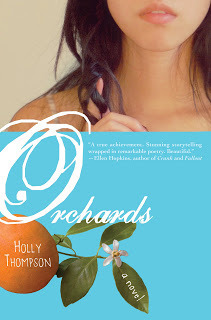 It was indeed satisfying to receive this award because Orchards was intertwined with SCBWI from start to finish—with me finding inspiration to write in verse after conversations with author Ellen Hopkins at my first SCBWI LA conference shortly after I became the SCBWI Tokyo regional advisor; receiving a helpful poetry critique from poet Lee Bennett Hopkins also in LA; getting feedback on early chapters from editors and peers at SCBWI winter conference Writers Intensives and from SCBWI Tokyo members; committing to completing a first draft after meeting agent Laura Rennert during an SCBWI Tokyo Writers Day; rushing to revise in time to apply to the Nevada SCBWI Mentor Program; meeting agent Jamie Weiss Chilton at the mentor program’s opening conference; receiving guidance from my assigned mentor Esther Hershenhorn; signing with my agent Jamie Weiss Chilton during the 2010 SCBWI Summer conference in LA as authors Linda Sue Park and Kathleen Duey looked on; doing revisions under my agent Jamie’s guidance; having the work accepted by Delacorte even before the end of the Nevada mentor program; and receiving this Crystal Kite Award for the Middle East/India/Asia. SCBWI provided me with so many incredible opportunities along the way and has played a major role in this writing journey. What a joy to be able to celebrate with fellow members of SCBWI Tokyo on Friday evening.
It was indeed satisfying to receive this award because Orchards was intertwined with SCBWI from start to finish—with me finding inspiration to write in verse after conversations with author Ellen Hopkins at my first SCBWI LA conference shortly after I became the SCBWI Tokyo regional advisor; receiving a helpful poetry critique from poet Lee Bennett Hopkins also in LA; getting feedback on early chapters from editors and peers at SCBWI winter conference Writers Intensives and from SCBWI Tokyo members; committing to completing a first draft after meeting agent Laura Rennert during an SCBWI Tokyo Writers Day; rushing to revise in time to apply to the Nevada SCBWI Mentor Program; meeting agent Jamie Weiss Chilton at the mentor program’s opening conference; receiving guidance from my assigned mentor Esther Hershenhorn; signing with my agent Jamie Weiss Chilton during the 2010 SCBWI Summer conference in LA as authors Linda Sue Park and Kathleen Duey looked on; doing revisions under my agent Jamie’s guidance; having the work accepted by Delacorte even before the end of the Nevada mentor program; and receiving this Crystal Kite Award for the Middle East/India/Asia. SCBWI provided me with so many incredible opportunities along the way and has played a major role in this writing journey. What a joy to be able to celebrate with fellow members of SCBWI Tokyo on Friday evening.
The Crystal Kite award is indeed crystal and comes with its own set of white gloves for handling. Now to find a a nice, low, earthquake-stable location for displaying it!
And for those of you with children's or YA books published in 2012, here is the info for entering for the 2013 award: SCBWI Crystal Kite Awards . Good luck!
 2012 Crystal Kite Award for Orchards
2012 Crystal Kite Award for OrchardsSCBWI's Lee Wind did an interview with me on the SCBWI Blog about the award and my involvement with SCBWI.
And on Friday evening at SCBWI Tokyo's final event of 2012, I was completely surprised with an award presentation made by my wonderful Assistant Regional Advisor Jenny Desmond Walters who said some lovely words about first encountering early drafts of Orchards when she was a member of the SCBWI Tokyo online critique group her first time living in Japan about seven years ago--stories do go from scribbles, to full drafts, to publication.
 Receiving the Crystal Kite Award at the SCBWI Tokyo Bonenkai dinner
Receiving the Crystal Kite Award at the SCBWI Tokyo Bonenkai dinnerThe SCBWI announcement of the 2012 Crystal Kite award winners shares these words about the awards:
The SCBWI Crystal Kite Awards recognize great books from the 70 SCBWI regions around the world. Each regional chapter was assigned to one of 15 divisions and the membership in each division voted for their favorite book published by an SCBWI member that year. “The SCBWI is pleased to reward excellence in children’s books,” President Stephen Mooser stated. “These awards honor authors from our many regions and help bring worthy books into the spotlight.”
The Crystal Kite Awards are a regional complement of the annual SCBWI Golden Kite Award which are given in 4 children’s literature categories. Both awards are unique as they are chosen by other writers and illustrators, making them the only peer-given awards in publishing for young readers. “Like the Golden Kite Awards, the Crystal Kites are selected by peers---authors and artists working in the children’s book field,” SCBWI Executive Director Lin Oliver commented. “That makes them unique and especially satisfying to receive.”
 It was indeed satisfying to receive this award because Orchards was intertwined with SCBWI from start to finish—with me finding inspiration to write in verse after conversations with author Ellen Hopkins at my first SCBWI LA conference shortly after I became the SCBWI Tokyo regional advisor; receiving a helpful poetry critique from poet Lee Bennett Hopkins also in LA; getting feedback on early chapters from editors and peers at SCBWI winter conference Writers Intensives and from SCBWI Tokyo members; committing to completing a first draft after meeting agent Laura Rennert during an SCBWI Tokyo Writers Day; rushing to revise in time to apply to the Nevada SCBWI Mentor Program; meeting agent Jamie Weiss Chilton at the mentor program’s opening conference; receiving guidance from my assigned mentor Esther Hershenhorn; signing with my agent Jamie Weiss Chilton during the 2010 SCBWI Summer conference in LA as authors Linda Sue Park and Kathleen Duey looked on; doing revisions under my agent Jamie’s guidance; having the work accepted by Delacorte even before the end of the Nevada mentor program; and receiving this Crystal Kite Award for the Middle East/India/Asia. SCBWI provided me with so many incredible opportunities along the way and has played a major role in this writing journey. What a joy to be able to celebrate with fellow members of SCBWI Tokyo on Friday evening.
It was indeed satisfying to receive this award because Orchards was intertwined with SCBWI from start to finish—with me finding inspiration to write in verse after conversations with author Ellen Hopkins at my first SCBWI LA conference shortly after I became the SCBWI Tokyo regional advisor; receiving a helpful poetry critique from poet Lee Bennett Hopkins also in LA; getting feedback on early chapters from editors and peers at SCBWI winter conference Writers Intensives and from SCBWI Tokyo members; committing to completing a first draft after meeting agent Laura Rennert during an SCBWI Tokyo Writers Day; rushing to revise in time to apply to the Nevada SCBWI Mentor Program; meeting agent Jamie Weiss Chilton at the mentor program’s opening conference; receiving guidance from my assigned mentor Esther Hershenhorn; signing with my agent Jamie Weiss Chilton during the 2010 SCBWI Summer conference in LA as authors Linda Sue Park and Kathleen Duey looked on; doing revisions under my agent Jamie’s guidance; having the work accepted by Delacorte even before the end of the Nevada mentor program; and receiving this Crystal Kite Award for the Middle East/India/Asia. SCBWI provided me with so many incredible opportunities along the way and has played a major role in this writing journey. What a joy to be able to celebrate with fellow members of SCBWI Tokyo on Friday evening. The Crystal Kite award is indeed crystal and comes with its own set of white gloves for handling. Now to find a a nice, low, earthquake-stable location for displaying it!
And for those of you with children's or YA books published in 2012, here is the info for entering for the 2013 award: SCBWI Crystal Kite Awards . Good luck!
Published on December 08, 2012 18:52
December 5, 2012
Japanese to English Translators--Some Updates on my Heroes
Through my project Tomo: Friendship Through Fiction, which just made its first donation to Hope for Tomorrow (see my post Giving Through Tomo), I had the chance to edit stories translated from Japanese into English. It was a wonderful opportunity and challenge, and I hope I'll have the chance to tackle such an editing role again down the road.
I closely follow the writing and translation work of the many Tomo contributors, and today I enjoyed a coffee/hot chocolate with Alexander O. Smith, who is now also based in Kamakura (and featured in an article in the current issue of Kamakura Shunju ).
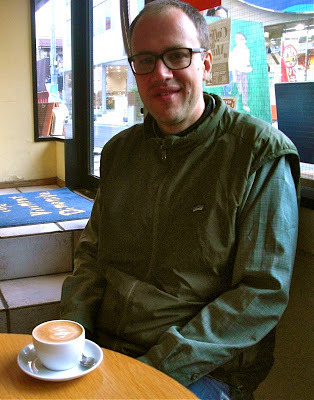 It was great to get caught up on his projects, including the Math Girls books published by his new venture Bento Books and his translation work with Kajiya Productions, and to talk books, translation, writing and editing.
It was great to get caught up on his projects, including the Math Girls books published by his new venture Bento Books and his translation work with Kajiya Productions, and to talk books, translation, writing and editing.
Recently another Tomo translator Avery Fischer Udagawa made a Skype visit to Yokohama International School to talk about translation--see this blog post about Avery's visit (by Tomo contributor Trevor Kew). I'm so pleased to see translators doing school visits!
Many of the Tomo translators are members of the SCBWI Tokyo Translation Group and you can check out their posts on the Translation Group Blog--the most recent is about J-Lit, the Japan Literature Publishing Project.
Literature in translation is so important, and I'm hopeful that we'll begin to see more and more Japanese literature appearing in English. I'm planning to read a number of novels in translation in the coming year. Feel free to make recommendations!

I closely follow the writing and translation work of the many Tomo contributors, and today I enjoyed a coffee/hot chocolate with Alexander O. Smith, who is now also based in Kamakura (and featured in an article in the current issue of Kamakura Shunju ).
 It was great to get caught up on his projects, including the Math Girls books published by his new venture Bento Books and his translation work with Kajiya Productions, and to talk books, translation, writing and editing.
It was great to get caught up on his projects, including the Math Girls books published by his new venture Bento Books and his translation work with Kajiya Productions, and to talk books, translation, writing and editing.Recently another Tomo translator Avery Fischer Udagawa made a Skype visit to Yokohama International School to talk about translation--see this blog post about Avery's visit (by Tomo contributor Trevor Kew). I'm so pleased to see translators doing school visits!
Many of the Tomo translators are members of the SCBWI Tokyo Translation Group and you can check out their posts on the Translation Group Blog--the most recent is about J-Lit, the Japan Literature Publishing Project.
Literature in translation is so important, and I'm hopeful that we'll begin to see more and more Japanese literature appearing in English. I'm planning to read a number of novels in translation in the coming year. Feel free to make recommendations!
Published on December 05, 2012 02:18
November 16, 2012
ARCs for The Language Inside--Arrived!
Look what came in the mail this week! The Advance Reader's Copies (ARCs) of my verse novel The Language Inside.
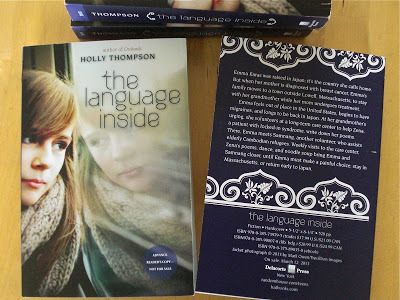 ARCs of Holly Thompson's The Language InsideI love the border design on the back which repeats on interior pages. Can't wait to see the hard cover when it's published in May.
ARCs of Holly Thompson's The Language InsideI love the border design on the back which repeats on interior pages. Can't wait to see the hard cover when it's published in May.
So my work this coming week is cut out for me--checking and editing the 517 first-pass pages of this, my second verse novel--Orchards was my first. Here's the description for The Language Inside :
<!-- /* Font Definitions */ @font-face {font-family:Times; panose-1:2 0 5 0 0 0 0 0 0 0; mso-font-charset:0; mso-generic-font-family:auto; mso-font-pitch:variable; mso-font-signature:3 0 0 0 1 0;} @font-face {font-family:"MS 明朝"; panose-1:0 0 0 0 0 0 0 0 0 0; mso-font-charset:128; mso-generic-font-family:roman; mso-font-format:other; mso-font-pitch:fixed; mso-font-signature:1 134676480 16 0 131072 0;} @font-face {font-family:"Cambria Math"; panose-1:2 4 5 3 5 4 6 3 2 4; mso-font-charset:0; mso-generic-font-family:auto; mso-font-pitch:variable; mso-font-signature:3 0 0 0 1 0;} @font-face {font-family:Cambria; panose-1:2 4 5 3 5 4 6 3 2 4; mso-font-charset:0; mso-generic-font-family:auto; mso-font-pitch:variable; mso-font-signature:-536870145 1073743103 0 0 415 0;} /* Style Definitions */ p.MsoNormal, li.MsoNormal, div.MsoNormal {mso-style-unhide:no; mso-style-qformat:yes; mso-style-parent:""; margin:0cm; margin-bottom:.0001pt; mso-pagination:widow-orphan; font-size:12.0pt; font-family:Cambria; mso-ascii-font-family:Cambria; mso-ascii-theme-font:minor-latin; mso-fareast-font-family:"MS 明朝"; mso-fareast-theme-font:minor-fareast; mso-hansi-font-family:Cambria; mso-hansi-theme-font:minor-latin; mso-bidi-font-family:"Times New Roman"; mso-bidi-theme-font:minor-bidi;} .MsoChpDefault {mso-style-type:export-only; mso-default-props:yes; font-family:Cambria; mso-ascii-font-family:Cambria; mso-ascii-theme-font:minor-latin; mso-fareast-font-family:"MS 明朝"; mso-fareast-theme-font:minor-fareast; mso-hansi-font-family:Cambria; mso-hansi-theme-font:minor-latin; mso-bidi-font-family:"Times New Roman"; mso-bidi-theme-font:minor-bidi;} @page WordSection1 {size:612.0pt 792.0pt; margin:72.0pt 90.0pt 72.0pt 90.0pt; mso-header-margin:36.0pt; mso-footer-margin:36.0pt; mso-paper-source:0;} div.WordSection1 {page:WordSection1;} </style>--> <br /><div class="MsoNormal"><span style="font-size: x-small;"><span style="font-family: Times,"Times New Roman",serif;">Emma Karas was raised in Japan; it’s the country she calls home. But when her mother is diagnosed with breast cancer, Emma’s family moves to a town outside Lowell, Massachusetts to stay with her grandmother while her mom undergoes treatment.<span style="font-size: x-small;"> </span>Emma feels out of place in the United States, begins to have migraines, and longs to be back in Japan. At her grandmother’s urging, she volunteers in a long-term care center to help Zena, a patient with locked-in syndrome, write down her poems. There, Emma meets Samnang, another volunteer, who assists elderly Cambodian refugees. Weekly visits to the care center, Zena’s poems, dance, and noodle soup bring Emma and Samnang closer, until Emma must make a painful choice: stay in Massachusetts, or return early to Japan. <i>The Language Inside</i> is a verse novel rich in language both spoken and unspoken and poetry that crosses boundaries to create a story layered with love, loss, movement and words. </span></span></div><div class="MsoNormal"><br /></div><div class="MsoNormal"><span style="font-size: x-small;"><span style="font-family: Times,"Times New Roman",serif;"><span style="font-size: small;"><span style="font-size: small;">And now you can pre-order <i>The Lang<span style="font-size: small;">uage Inside </span></i><span style="font-size: small;"><span style="font-size: small;"><a href="http://amzn.to/SyO2ar"><span style="font-size: small;">via </span>U.S. Amazon</a> or <a href="http://amzn.to/SyOJjP">Japan Amazon</a></span></span><i><span style="font-size: small;">. </span></i><span style="font-size: small;"><span style="font-size: small;">Holiday shopping anyone?</span></span></span></span></span></span> </div><div class="blogger-post-footer"><img width='1' height='1' src='https://blogger.googleusercontent.com...' alt='' /></div>
 ARCs of Holly Thompson's The Language InsideI love the border design on the back which repeats on interior pages. Can't wait to see the hard cover when it's published in May.
ARCs of Holly Thompson's The Language InsideI love the border design on the back which repeats on interior pages. Can't wait to see the hard cover when it's published in May. So my work this coming week is cut out for me--checking and editing the 517 first-pass pages of this, my second verse novel--Orchards was my first. Here's the description for The Language Inside :
<!-- /* Font Definitions */ @font-face {font-family:Times; panose-1:2 0 5 0 0 0 0 0 0 0; mso-font-charset:0; mso-generic-font-family:auto; mso-font-pitch:variable; mso-font-signature:3 0 0 0 1 0;} @font-face {font-family:"MS 明朝"; panose-1:0 0 0 0 0 0 0 0 0 0; mso-font-charset:128; mso-generic-font-family:roman; mso-font-format:other; mso-font-pitch:fixed; mso-font-signature:1 134676480 16 0 131072 0;} @font-face {font-family:"Cambria Math"; panose-1:2 4 5 3 5 4 6 3 2 4; mso-font-charset:0; mso-generic-font-family:auto; mso-font-pitch:variable; mso-font-signature:3 0 0 0 1 0;} @font-face {font-family:Cambria; panose-1:2 4 5 3 5 4 6 3 2 4; mso-font-charset:0; mso-generic-font-family:auto; mso-font-pitch:variable; mso-font-signature:-536870145 1073743103 0 0 415 0;} /* Style Definitions */ p.MsoNormal, li.MsoNormal, div.MsoNormal {mso-style-unhide:no; mso-style-qformat:yes; mso-style-parent:""; margin:0cm; margin-bottom:.0001pt; mso-pagination:widow-orphan; font-size:12.0pt; font-family:Cambria; mso-ascii-font-family:Cambria; mso-ascii-theme-font:minor-latin; mso-fareast-font-family:"MS 明朝"; mso-fareast-theme-font:minor-fareast; mso-hansi-font-family:Cambria; mso-hansi-theme-font:minor-latin; mso-bidi-font-family:"Times New Roman"; mso-bidi-theme-font:minor-bidi;} .MsoChpDefault {mso-style-type:export-only; mso-default-props:yes; font-family:Cambria; mso-ascii-font-family:Cambria; mso-ascii-theme-font:minor-latin; mso-fareast-font-family:"MS 明朝"; mso-fareast-theme-font:minor-fareast; mso-hansi-font-family:Cambria; mso-hansi-theme-font:minor-latin; mso-bidi-font-family:"Times New Roman"; mso-bidi-theme-font:minor-bidi;} @page WordSection1 {size:612.0pt 792.0pt; margin:72.0pt 90.0pt 72.0pt 90.0pt; mso-header-margin:36.0pt; mso-footer-margin:36.0pt; mso-paper-source:0;} div.WordSection1 {page:WordSection1;} </style>--> <br /><div class="MsoNormal"><span style="font-size: x-small;"><span style="font-family: Times,"Times New Roman",serif;">Emma Karas was raised in Japan; it’s the country she calls home. But when her mother is diagnosed with breast cancer, Emma’s family moves to a town outside Lowell, Massachusetts to stay with her grandmother while her mom undergoes treatment.<span style="font-size: x-small;"> </span>Emma feels out of place in the United States, begins to have migraines, and longs to be back in Japan. At her grandmother’s urging, she volunteers in a long-term care center to help Zena, a patient with locked-in syndrome, write down her poems. There, Emma meets Samnang, another volunteer, who assists elderly Cambodian refugees. Weekly visits to the care center, Zena’s poems, dance, and noodle soup bring Emma and Samnang closer, until Emma must make a painful choice: stay in Massachusetts, or return early to Japan. <i>The Language Inside</i> is a verse novel rich in language both spoken and unspoken and poetry that crosses boundaries to create a story layered with love, loss, movement and words. </span></span></div><div class="MsoNormal"><br /></div><div class="MsoNormal"><span style="font-size: x-small;"><span style="font-family: Times,"Times New Roman",serif;"><span style="font-size: small;"><span style="font-size: small;">And now you can pre-order <i>The Lang<span style="font-size: small;">uage Inside </span></i><span style="font-size: small;"><span style="font-size: small;"><a href="http://amzn.to/SyO2ar"><span style="font-size: small;">via </span>U.S. Amazon</a> or <a href="http://amzn.to/SyOJjP">Japan Amazon</a></span></span><i><span style="font-size: small;">. </span></i><span style="font-size: small;"><span style="font-size: small;">Holiday shopping anyone?</span></span></span></span></span></span> </div><div class="blogger-post-footer"><img width='1' height='1' src='https://blogger.googleusercontent.com...' alt='' /></div>
Published on November 16, 2012 17:07



